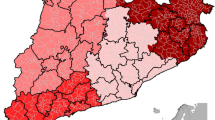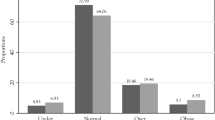Abstract
The use of height data to measure living standards is now a well-established method in economic history. By using a new source of nineteenth century Texas state prison records, the present study contrasts the heights of comparable blacks and whites between the Civil War and Reconstruction in the American South. White stature exceeded black stature. Between 1850 and 1870, black stature declined by more than 1 cm but recovered toward the end of the nineteenth century. Postbellum white stature declined by more than 1 1/2 cm over the same period yet never recovered.



Similar content being viewed by others
Notes
I am currently collecting nineteenth-century Irish prison records. Irish prison enumerators also used light, medium, dark, fresh, and sallow to describe white prisoners in prisons from a traditionally white population. To date, no inmate in an Irish prison has been recorded with a complexion consistent with African heritage.
References
Atack J, Bateman F (1987) To their own soil: agriculture in the Antebellum North. Iowa State University Press Ames, Iowa
Barondess DA, Nelson DA, Schlaen SE (1997) Whole body bone, fat and lean mass in black and white men. J Bone Miner Res 12:967–971
Bleakley H (2003) Disease and development: evidence from the American South. J Eur Econ Assoc 1(2):376–386
Bodenhorn H (1999) A troublesome caste: height and nutrition of Antebellum Virginia’s rural free blacks. J Econ Hist 59(4):972–996
Bodenhorn H (2002) Mulatto advantage: the biological consequences of complexion in rural antebellum Virginia. J Interdiscip Hist 33(1):21–46
Bogin B (1991) Measurement of growth variability and environmental quality in Guatemalan children. Ann Hum Biol 18(4):285–294
Breeden J (1988) Disease and southern distinctiveness. In: Savitt TL, Young JA (eds) Disease and distinctiveness in the American South. University of Tennessee Press, Knoxville, TN
Brinkley GL (1997) The decline in southern agricultural output, 1860–1880. J Econ Hist 57(1):116–138
Coclanis PA, Komlos J (1995) Nutrition and economic development in post reconstruction South Carolina. Soc Sci Hist 19(1):91–115
Coelho P, McGuire R (2000) Diets versus disease: the anthropometrics of slave children. J Econ Hist 60(1):232–246
Crouch BA (1984) Sprit of lawlessness: white violence; Texas Blacks, 1865–1868. J Soc Hist 18(2):217–232
Cuff T (1992) A weighty issue revisited: new evidence on commercial swine weights and pork production in mid-nineteenth century America. Agric Hist 66(4):55–74
Cuff T (2004) Historical anthropometrics. In: Whaples R (ed) EH.Net Encyclopedia. Available at http://eh.net/encyclopedia/article/cuff.anthropometric
Eveleth PB, Tanner JM (1976) Worldwide variation in human growth, 2nd edn. Cambridge University Press, Cambridge, UK
Ferrie JP (1997) The entry into the U.S. labor market or antebellum European immigrants, 1840–1860. Explor Econom Hist 34(3):295–233
Fite G (1986) The agricultural trap in the South. Agric Hist 60(4):38–50
Fogel RW, Engerman SL, Trussell J, Floud R, Pope C, Wimmer L (1978) Economics of mortality in North America, 1650–1910: a description of a research project. Hist Methods 11(2):75–108
Fogel RW, Engerman SL, Floud R, Friedman F, Margo R, Sakoloff K, Steckel R, Trussell J, Villaflor G, Wachter K (1983) Secular changes in American and British stature and nutrition. J Interdiscip Hist 14(2):445–481
Friedman LM (1993) Crime and punishment in American history. Basic books, New York, NY
Godoy RE, Goodman R, Levins R, Leonard WR (2005) Anthropometric variability in the USA. Ann Hum Biol 32(4):469–485
Haines M, Craig L, Weiss T (2003) The short and the dead: nutrition, mortality and the “Antebellum Puzzle” in the United States. J Econ Hist 63(2):382–413
Harris JW (2006) The making of the American South: a short history 1500–1877. Blackwell, Oxford, England
Higgs R (1977) Competition and coercion. University of Chicago Press, Chicago, IL
Hilliard SB (1972) Hog, meat and hoecake: food supply in the Old South, 1840–1860. Southern Illinois University Press, Carbondale, IL
Komlos J (1985) Stature and nutrition in the Habsburg monarchy: the standard of living and economic development in the eighteenth century. Am Hist Rev 90(5):1149–1161
Komlos J (1987) The height and weight of West Point cadets: dietary change in antebellum America. J Econ Hist 47(4):897–927
Komlos J (1992) Toward an anthropometric history of African-Americans: the case of the free blacks in antebellum Maryland. In: Goldin C, Rockoff H (eds) Strategic factors in nineteenth century American economic history: a volume to honor Robert W. Fogel. University of Chicago Press, Chicago, IL, pp 297–329
Komlos J (1998) Shrinking in a growing economy? The mystery of physical stature during the industrial revolution. J Econ Hist 58(3):779–802
Komlos J, Alecke B (1996) The economics of antebellum slave heights reconsidered. J Interdiscip Hist 26(3):437–457, Winter
Komlos J, Coclanis P (1997) On the puzzling cycle in the biological standard of living: the case of antebellum Georgia. Explor Econom Hist 34(4):433–459
Komlos J, Baur M (2004) From tallest to (one of) the fattest: the enigmatic fate of American population in the 20th century. Econ Hum Biol 2(1):57–74
Lynch J, Kaplan G (1997) Understanding how inequality in the distribution of income affects human health. J Health Psychol 2(3):297–314
Margo R, Steckel R (1982) Heights of American slaves: new evidence on nutrition and health. Soc Sci Hist 6(4):516–538
Margo R, Steckel R (1983) Heights of native born northern whites during the antebellum era. J Econ Hist 43(1):167–174
Margo R, Steckel R (1992) The Nutrition and health of slaves and antebellum southern whites. In: Fogel RW, Engerman SL (eds) Without consent or contract: conditions of slave life and the transition to freedom. W. W. Norton, New York, NY, pp 508–521
Metzer JM (1975) Rational management, modern business practices and economies of scale in antebellum southern plantations. Explor Econ Hist 12(2):123–150
Monkkonen E (2002) Crime, justice, history. The Ohio State University Press, Columbus, OH
Oaxaca RL (1973) Male female wage differentials in urban labor markets. Int Econ Rev 14(3):693–709
Pritchett JB, Freudenberger H (1992) A peculiar sample: the selection of slaves for the New Orleans market. J Econ Hist 52(1):107–127
Ransom R, Sutch R (1977) One kind of freedom: the economic consequences of emancipation. Cambridge University Press, Cambridge, UK
Rees R, Komlos J, Long N, Woitek U (2003) Optimal food allocation in a slave economy. J Popul Econ 16:21–36
Reid JD (1979) White land, black labor and agricultural stagnation: the causes and effects of sharecropping in the postbellum south. Explor Econ Hist 16(1):31–55
Rose J (1989) Biological consequences of segregation and economic depravity: a post-slavery population from Southwest Arkansas. J Econ Hist 49(2):351–360
Rosenbloom J (2002) Looking for work, searching for workers: American labor markets during industrialization. Cambridge University Press, Cambridge, UK
Sokoloff KL, Villaflor GC (1982) The early achievement of modern stature in America. Soc Sci Hist 6(4):453–481
Soltow L (1975) Men and wealth in the United States, 1850–1870. Yale University Press, New Haven, CT
Steckel R (1986) A peculiar population: the nutrition, health, and mortality of American slaves from childhood to mortality. J Econ Hist 46(3):721–741
Steckel R (1989) Household Migration and Settlement in the United States, 1850–1860. Explor Econ Hist 26(2):190–218
Steckel R (1992a) Work, disease and diet in the health and mortality of American slaves. In: Fogel RF, Engerman SL (eds) Without consent or contract: conditions of slave life and the transition to freedom, technical papers, vol. 2. W.W. Norton, New York, NY
Steckel R (1992b) Work, disease and diet in the health and mortality of American slaves. In: Fogel RW, Engerman SL (eds) Without consent or contract: the rise and fall of American slavery, conditions of slave life and the transition to freedom: technical papers. W. W. Norton, New York, NY, pp 489–507
Steckel R (1994) Heights and health in the United States. In: Komlos J (ed) Stature, living standards and economic development. University of Chicago Press, Chicago, IL, pp 153–170
Steckel R (1995) Stature and the standard of living. J Econ Lit 33(4):1903–1940
Steckel R (2000) Diets versus disease in the anthropometrics of slave children: a reply. J Econ Hist 60(1):247–259
Steckel R, Haurin D (1994) Health and nutrition in the American Midwest: evidence from the height of Ohio national guardsman. 1850–1910. In: Komlos J (ed) Stature, living standards and economic development. Chicago University Press, Chicago, IL, pp 117–128
Sutch R (1975) The treatment received by American slaves: a critical review of the evidence presented in time on the cross. Explor Econ Hist 12(4):335–438
Tanner JM (1962) Growth at adolescence. Charles C. Thomas, Springfield, IL
Tanner JM (1977) Hormonal, genetic and environmental factors controlling growth. In: Harrison GA, Weiner JS, Tanner JM, Barnicot NA (eds) Human biology: an introduction to human evolution, variation, growth and ecology, 2nd edn. Oxford University Press, Oxford, England, pp 335–351
Troesken W (2004) Water, race and disease. MIT, Cambridge, UK
Wahl JB (1996) The jurisprudence of American slave sales. J Econ Hist 56(1):143–169
Wahl JB (1997) Legal constraints on slave masters: the problem of social cost. Am J Legal Hist 41(1):1–24
Walker DR (1988) Penology for profit: a history of the Texas prison system, 1867–1912. Texas A & M University Press, College Station, TX
Woodward VC (1951) Origins of the new South, 1877–1913. Louisiana State University Press, Baton Rouge, LA
Wright G (1978) The political economy of the cotton South: households, markets, and wealth in the nineteenth century. W. W. Norton, New York, NY
Acknowledgments
I appreciate comments from Tom Maloney, John Komlos, Paul Hodges, Roger Ransom, Jeremy Atack, and Dora Costa. Comments from two anonymous referees were especially helpful. I am also grateful to the participants at the 2004 Social Science History Association conference. Craig O. Davis, Sandy Triepke, and Anita Voorhies provided excellent research assistance.
Author information
Authors and Affiliations
Corresponding author
Additional information
Responsible editor: Christian Dustmann
Rights and permissions
About this article
Cite this article
Carson, S.A. African-American and white inequality in the nineteenth century American South: a biological comparison. J Popul Econ 22, 739–755 (2009). https://doi.org/10.1007/s00148-007-0167-2
Received:
Accepted:
Published:
Issue Date:
DOI: https://doi.org/10.1007/s00148-007-0167-2




